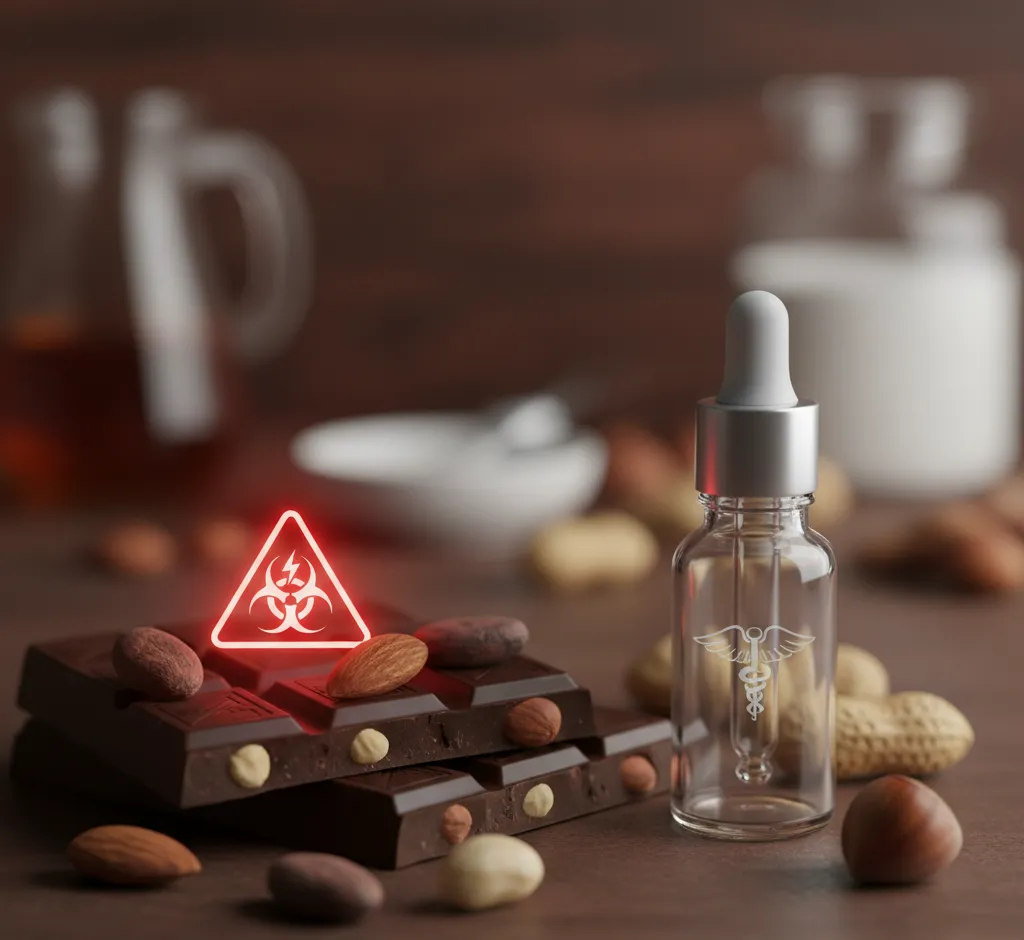Beyond the Craving: Understanding Chocolate Allergy Symptoms and Causes
Explore the symptoms and complex causes of chocolate allergy and sensitivity. Learn to distinguish between a true cocoa allergy, a reaction to dairy or nuts, and common intolerances like histamine or caffeine.

Beyond the Craving: Understanding Chocolate Allergy Symptoms and Causes
Chocolate, the world's most beloved confection, is often associated with comfort, celebration, and pure indulgence. Yet, for a small but significant number of individuals, this sweet treat can trigger a confusing and uncomfortable—or even dangerous—adverse reaction. While a true **chocolate allergy** is relatively rare, reactions to chocolate or chocolate-containing products are far more common, often being attributed to components *other* than the cocoa bean itself. Understanding the difference between a true allergy, a sensitivity, and a reaction to a cross-contaminant is crucial for proper diagnosis and management.
This comprehensive guide delves into the mechanisms behind adverse reactions to chocolate, explores the wide spectrum of symptoms, and outlines the primary culprits—ranging from nuts and dairy to common additives like corn and soy—that are often the true source of distress.
The Distinction: Allergy vs. Sensitivity vs. Intolerance
When someone experiences an adverse reaction after eating chocolate, the first step is to correctly identify the type of reaction, as this dictates the necessary medical approach.
- True Allergy (IgE-Mediated): This is a rare, life-threatening immune response. The body's immune system mistakenly identifies a protein in the cocoa bean as a threat and produces Immunoglobulin E (IgE) antibodies to fight it. Symptoms are often immediate and can affect multiple systems.
- Sensitivity (Non-IgE-Mediated): This involves the immune system, but not the IgE antibodies. Symptoms are usually gastrointestinal and can be delayed by hours or even days. This is much less severe than a true allergy.
- Intolerance: This is the most common reaction and is non-immunological. It involves the digestive system's inability to properly break down a substance, such as lactose in milk chocolate or compounds like caffeine and theobromine. Symptoms are generally limited to the gut (e.g., bloating, gas, stomach pain).
Identifying the True Culprits in Chocolate Reactions
The vast majority of allergic reactions attributed to chocolate are actually caused by one of its common ingredients or contaminants. A diagnostic panel rarely confirms an allergy to the cocoa bean itself.
1. Common Allergenic Ingredients
These ingredients are staples in nearly all chocolate manufacturing and are among the most common food allergens:
- Dairy (Milk Protein): Found in milk chocolate, this is perhaps the single most frequent cause of 'chocolate' allergy symptoms, particularly in children. The protein casein or whey triggers the reaction.
- Nuts (Peanuts and Tree Nuts): Many chocolates contain nut pieces (almonds, hazelnuts, walnuts) or are processed on equipment that also handles nuts. Trace amounts from cross-contamination are enough to cause a severe reaction in highly sensitive individuals.
- Soy (Soy Lecithin): Soy lecithin is used as an emulsifier to give chocolate a smooth texture. While refined soy oil is generally safe, the protein in soy lecithin can trigger reactions in those with a soy allergy.
- Corn (Corn Syrup, Dextrose): Corn-derived ingredients are often used in fillings or as sweeteners. A corn allergy can present as a reaction to the final chocolate product.
2. Naturally Occurring Compounds
Certain chemical compounds naturally present in cocoa can trigger intolerance or sensitivity symptoms, often mimicking an allergic reaction:
- Caffeine and Theobromine: These stimulating methylxanthines can cause symptoms of intolerance, such as heart palpitations, anxiety, headaches, or jitters, especially when consumed in large quantities.
- Histamine and Tyramine: Fermented foods like chocolate are rich in histamines. In individuals with HI, consuming chocolate can lead to reactions like headaches, flushing, itching, or digestive upset because their body cannot properly metabolize the histamine.
- Salicylates: These natural chemicals are found in various plant foods, including cocoa. People with salicylate sensitivity may experience hives, asthma symptoms, or nasal congestion after eating chocolate.
🍫 Spectrum of Chocolate Allergy Symptoms 🍫
The severity and type of symptoms depend heavily on whether the reaction is a true IgE allergy, a sensitivity, or an intolerance. A true allergy is systemic and requires immediate attention.
Common Allergic (IgE) Symptoms
These symptoms typically appear rapidly (within minutes to two hours) and often affect multiple body systems:
- Skin: Hives, rash, intense itching (pruritus), redness, or swelling of the lips, tongue, or face (angioedema).
- Respiratory: Nasal congestion, sneezing, runny nose, coughing, wheezing, shortness of breath, or tightness in the chest.
- Gastrointestinal: Abdominal pain, cramping, vomiting, or diarrhea.
Severe Allergic Reaction (Anaphylaxis)
Anaphylaxis is a life-threatening, multi-system reaction and is a medical emergency. If any of these symptoms occur, call emergency services immediately:
- A sudden drop in blood pressure (dizziness, fainting).
- A weak, rapid pulse.
- Throat swelling or a sensation of a lump in the throat (difficulty breathing or swallowing).
- Severe wheezing or difficulty breathing.
Intolerance and Sensitivity Symptoms
These are generally confined to the digestive tract and are not life-threatening:
- Heartburn or acid reflux.
- Bloating, gas, and flatulence.
- Migraine or tension headaches (often linked to tyramine or histamine).
- Nausea or general stomach upset.
Diagnostic and Management Strategies
If you suspect an allergy or severe sensitivity to chocolate or its components, consult an allergist. Self-diagnosis and elimination can be dangerous, especially when dealing with potential anaphylactic allergens.
Diagnosis: Pinpointing the Cause
- Skin Prick Test (SPT): A small amount of allergen (e.g., cocoa, milk, soy) is pricked onto the skin. A raised bump (wheal) indicates a potential IgE allergy.
- Blood Test (IgE RAST): Measures the amount of IgE antibodies in the blood specific to certain food proteins.
- Oral Food Challenge (OFC): Conducted under strict medical supervision, the patient is given gradually increasing doses of the suspected food. This is the 'gold standard' for allergy diagnosis.
Management and Avoidance
Once the allergen is identified, management focuses on strict avoidance. **Always read labels** for allergens like **milk**, **nuts**, and **soy**.
For those with a true cocoa allergy or severe sensitivity to natural compounds (like histamine), the following steps are key:
- Switch to Pure Carob: Carob is a popular substitute that looks and tastes similar to cocoa but is caffeine-free and less likely to trigger histamine-related symptoms. Ensure the carob product is free of cross-contaminants.
- Carry an Epinephrine Auto-Injector: If diagnosed with an IgE-mediated allergy (e.g., to milk, nuts, or cocoa), a doctor will prescribe an auto-injector (e.g., EpiPen) to be used immediately in the event of severe allergic symptoms.
- Consult a Registered Dietitian: A dietitian can help create a safe, balanced diet that eliminates the triggering compound while ensuring nutritional adequacy.
While a life without chocolate might seem like a dark prospect, understanding the true cause of the reaction allows individuals to manage their health effectively and safely. For many, switching to high-quality dark or pure cocoa products, or simply avoiding common additives, can restore their ability to enjoy a modified version of this timeless treat without fear.


